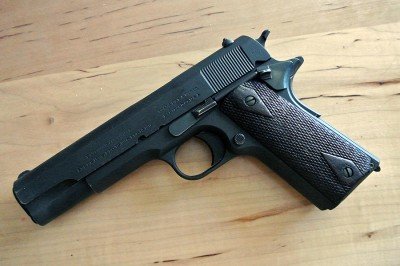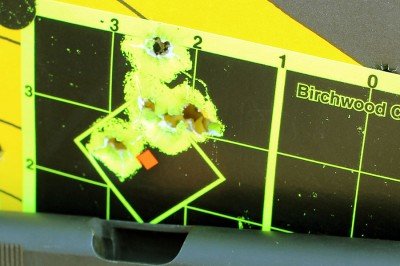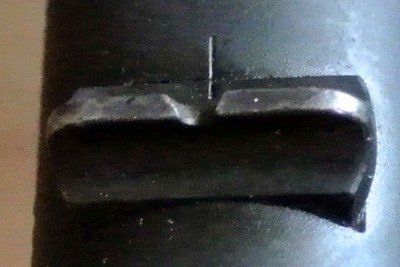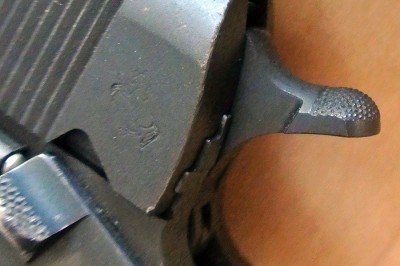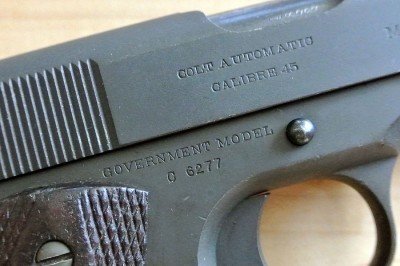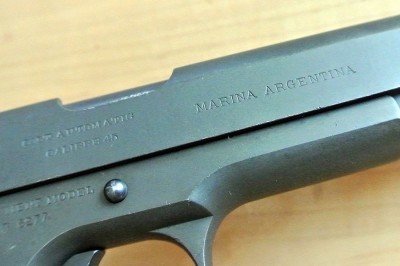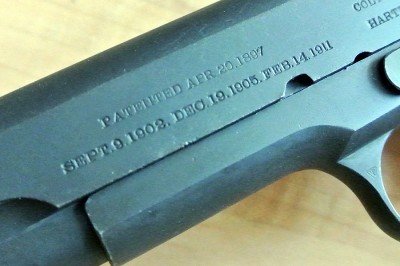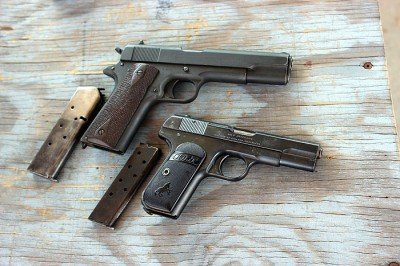Shooting History is our series where we take some old historic guns and, you guessed it, shoot ’em. The idea is to put them through the same testing and evaluations we do for modern guns. If there is something you would like to see reviewed in the series be sure to comment below and we will do out best to get our hands on a “shooter.” If you missed the first two reviews in this series you can find them here.
For this installment we will be looking at another old Colt pistol that was designed by John Browning. The best known of the old Colts actually, the 1911. But not just any 1911 will do for inclusion in this series. This example was made in 1913 and has an interesting history all its own. But more on that later. First, lets take a dangerously shallow dive into the world of the early 1911s.
Design
There has probably been more written about the 1911 than any other pistol (entire books, in fact). There’s no way to cover the subject in one article. Instead, I’ll go over some of the high points on the specs on the original 1911s, not the A1 update.
- Short recoil operation
- Grip and manual safety
- Single Action
- .45 ACP
- 7 round magazine
Unlike the later 1911 A1, the original had
- A flat mainspring housing
- A wide hammer spur and short grip safety spur
- No relief cuts on the frame
- A long trigger
- Smaller sights
Those are some of the highlights and differences the early 1911s have over the A1. There are other minor ones that changed slowly during production. The small things (like fineness of the checkering on the recoil spring plug and the manual safety) happened more like evolutions rather than big platform changes..
But what makes the 1911 such a legendary pistol? The fact that it was the primary side arm for the US Military from 1911 until 1984 is a big part of the equation. Lets take a look at the testing and trials that the 1911 went thought to get the job.
Trials and Tribulations
The final design of the 1911 really came about from a series of trials that the US Government put it and other pistols through. These tests let Colt and John Browning see how the pistol held up. There were also requirements that the design had to meet. A lot of the credit for the 1911 design can be attributed to the trials and specifications required for the new pistol. That is not to undermine the brilliance of John Browning, or his and Colt’s willingness to to tackle the challenge. The 1911 did not materialize overnight; it was a multi-year process.
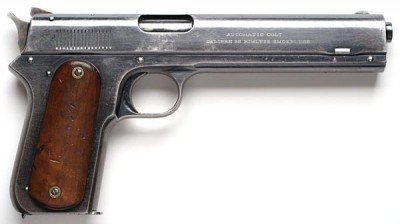
Colt 1900. (Photo: Coltautos.com)
1899-The Army announces that it is looking for a efficient and reliable automatic pistol to replace the revolver in use by the Calvary. A prototype of the Browning designed Colt 1900 is tested.
1900- The Colt 1900 enters production for the civilian market. It is a semiautomatic pistol chambered in .38 ACP and has a 6 inch barrel. Other notable design features are the use of two tilting links that allowed the barrel to move a short distance and the rear sight being used as a push button safety. It also features a full length slide.
1900- Also saw more testing of the now in production 1900. It was put through tests with the Mauser C96 and the Styer Mannlicher M1894. The Mannlicher failed but the Mauser and Colt preformed well enough for an order to be placed for more field tests of the two pistols.
1899-1902- During the Philippine-American War there were reports of the .38 Long Colt cartridge, used in the service revolvers, not having enough stopping power. This eventually lead to the requirement for the new pistols to be chamber in .45 or something larger.
1900-1905- Browning and Colt make improvements on the 1900 design from feedback during the on going Army field testing. The two barrel links show to be a weakness in the design. Colt makes some prototypes in .41 caliber but the two links can not withstand the heavier cartridge and no production pistols are made in this caliber.
1905- Browning designs and Colt releases the 1905 which is the first pistol chambered in .45 ACP–a round which was also designed by Browning. This design basically is a scaled up 1900 with some improvements made to the barrel links.
1905-1909- More testing of the Colt 1905 and slight changes made to the design continue. The 1907 variant is worth mentioning as the first of these Colts to have a grip safety (which the Ordnance Board asked to be included). The two barrel links and pins continue to be the main failure point.
1909- John Browning designs a single link barrel. This proves to be a winner. Prototypes are made in 1909 and 1910 with further testing done at trials.
1910- The army asked for a different angle on the grip more like what is found on the Luger. Browning changed the angle from 85 to 74 degrees. Once the thumb safety was added later in 1910, we have what is the first 1911.
March 1911- The final Browning/Colt design goes head to head with the Savage contender at yet another trial. The Colt fires 6,000 rounds with no failures. The “Pistol, Caliber .45, Model of 1911” is born.
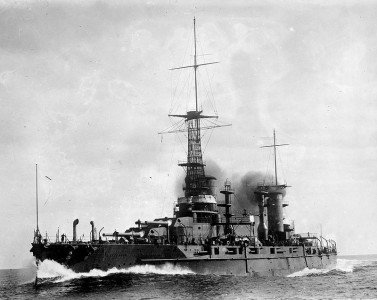
The Rivadavia. If you look really really closely you can see the review pistol in a holster on one of the sailors on deck.
This Old Colt
The review pistol was made in 1913. It was originally made to be sold on the commercial or civilian market, as the serial number starts with a C. But this old gal ended up enlisting in the Argentinian Navy.
In the early 20th Century Argentina commissioned two battleships to be built in the US. The two ships were the Rivadavia and Moreno. This was all a part of the bigger and bigger battleship race that the world was in at this time. When the ships were completed, the Argentinean Navy had the ships’ arms lockers filled with US arms, including this 1911.
Later 1911s would be made in Argentina. If you are looking at them on the used market, check the serial numbers. The first batch was made here–but most were not. And few remain with all of their matching parts.
The 1911s of this era where originally blued, but this one has been parkerized at some point in its life. A lot of the original parts have stayed with this pistol through the numerous rebuilds it has been subjected too before it showed up in a pawn shop in Reno, Nevada. The pistol is currently at Turnbull for restoration to bring it back to the way it looked in 1913. Look for an article about the process in the near future.
Shooting
So how does this 102 year old shoot? Like a champ. It is one of the best shooting 1911s that I have had the pleasure to shoot. There is one thing you have to look out for when shooting old 1911s like this. Hammer bite. With the update to the 1911A1, the hammer was made smaller and the grip safety spur enlarged. Other than making sure to grip the pistol a little lower to avoid the bite, this 1911 shoots and functions like a… 1911! I have put at least 500 rounds through it over the past few years without a single malfunction. The trigger is smooth, creep free and breaks right at 4.5 pounds. I have shot paper, cans and golf balls from 5 to 25 yards with this pistol. I have rang a 10 inch steel plate from a 100 yards with it as well. Other than cleaning and oiling, I have done nothing to the gun. It just flat out works like a 1911 is supposed to. Either Colt got it right in 1913 or the Argentinean Armors knew what they were doing. Probably a bit of both.
Relevance
I have ended the other articles in this series talking about if the design is still relevant today. If I was going to use this 1911 as an everyday carry gun, there are two things I would change. I would put a grip safety on it with an extended spur to cut out the hammer bite. The sights could use an update as well. They are tiny by today’s standards. But I will never do any of these things to this pistol. It is a piece of history and deserves to be preserved, not updated. That is why it is at Turnbull right now.
So is the 1911 design still relevant? One that functions and shoots like this one sure is. We have Colt, John Moses Browning and the countless people involved in the US Army Trials to thank for that.
[one_half]

The 1905 Colt. (Photo: Coltautos.com)
[/one_half][one_half_last]
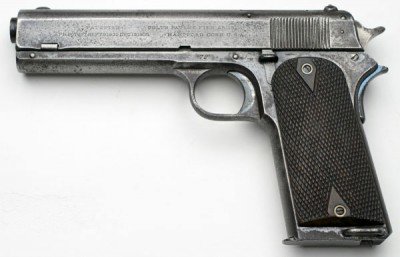
Colt 1907. The first of these pistols to have a grip safety. (Photo: Coltautos.com)
[/one_half_last][one_half]
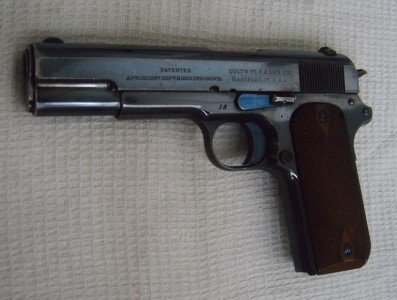
The Colt 1909 was the first one to use a single barrel link. The slide lock looks like that on the 1911 but no thumb safety. We are getting closer! (Photo: Coltautos.com)
[/one_half][one_half_last]
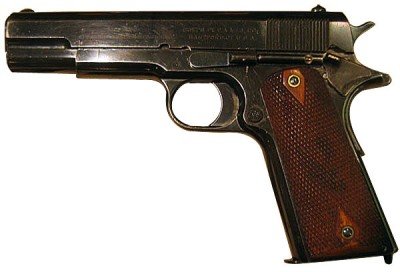
The Colt 1910. A few minor changes and this is a 1911. (Photo: Coltautos.com)
[/one_half_last][one_half]
[/one_half][one_half_last]
[/one_half_last][one_half]
[/one_half][one_half_last]
[/one_half_last][one_half]
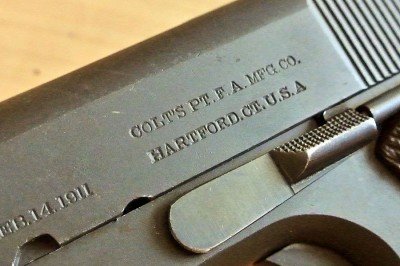
Made in Hartford, sailed to Argentina, to a pawn shop in Reno, then to Arkansas. And a few places in between I am sure.
[/one_half][one_half_last]
[/one_half_last]
***Big thanks to Coltautos.com — the website for collectors of Colt Automatic Pistols and Revolvers — for the pictures!
